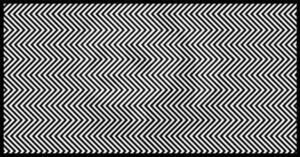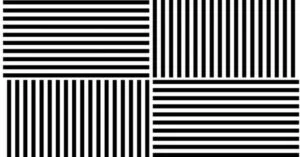According to studies, just 1% of people are able to identify the animal in this image. Is That Possible?
How Optical Illusions Work
With countless articles about optical illusions flooding social media, you might wonder how they work. One such image, shown in this article, features a hidden panda that only 1% of viewers can spot.
The McCollough Effect
This illusion, known as the McCollough Effect, tricks the mind. Staring at a colored grating for several minutes causes the brain to perceive a pink tinge or other colors when viewing black and white stripes. Tilting your head 90 degrees can alter the effect, and rotating the induction images can reverse it. The more you view the induction images, the longer the effect lasts.
Understanding Afterimages
This visual illusion is called an afterimage because the sight persists even after removing the stimulus. Scientists believe this results from continued activation of the visual system. Strong colors leave a lasting impression, tricking the visual system into believing the colors are still there.

Real-World Examples
The same phenomenon occurs when a camera flash lingers in your vision after you close your eyes. According to the Journal of Experimental Psychology, the effect can last over three months if a person looks at colorful gratings for an extended period. US psychologist Celeste McCollough Howard, who discovered this effect, called it the ‘contingent aftereffect.’
Testing the Effect
You can test this effect with the images below. The test is harmless and will only temporarily affect your vision. Scientists are investigating how this effect occurs, with some speculating it’s linked to neurons in the visual cortex. Others believe the brain is color-correcting the world and gets stuck, while another group thinks it resembles a withdrawal symptom from the absence of color.
Research and Findings
In a 1995 experiment, researchers tested a person with significant brain damage. They found that red-and-green and black-and-white gratings produced the effect, suggesting it occurs within the visual cortex. Julien Ciroux supports this research. Staring at the center of two induction images for a few minutes and alternating them can trigger the effect. Afterward, you might see red, green, or pinkish hues on black-and-white images.

Color Afterimages
Researchers proved that red and green stripes produce an afterimage. If the induction image is green, viewers see red on vertical grates and green on horizontal grates. With a red induction image, the colors reverse. Only red and green can produce this effect. Be cautious with long durations to avoid eye strain.
Potential Dangers
The McCollough Effect involves staring at vertical and horizontal lines, which might alter your color perception for up to three and a half months. Some people find it fascinating, while others experience headaches after just five minutes. To reverse the effect, stare at the original colored images again for half the original time, rotating them 90 degrees counterclockwise.
The Brain and Optical Illusions
Optical illusions occur because the brain tries to interpret visual input and understand the world. They trick the brain into seeing things that may not be real. The McCollough Effect has captivated scientists, who are eager to understand who is most affected by it.

Conducting Your Own Experiment
For those interested in studying this effect, we provide the necessary materials and experimental procedure below.



